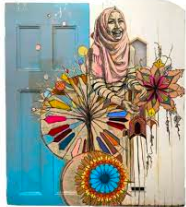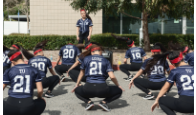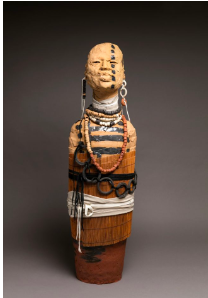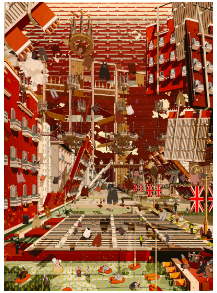This semester course provides students the opportunity to explore art through a variety of artmaking processes while focusing on broad concepts/big ideas that make connections between art and life. The standards and objectives are organized into five specific content strands: Creative Process; Critical Thinking and
Communication; History, Culture, and Citizenship; Innovation in the Arts; and Technique and Application. Students gain practical experience using a variety of art media, such as drawing, painting, printmaking, ceramics, sculpture, digital design, and mixed-media. Students will examine world cultures through contemporary
and historical art. Students develop visual literacy through written, visual, and verbal expression.
Essential Questions: What Are the Big Issues About Art? How and Why Do We Make Art? How Does Art Relate to History and Culture? How Do We Respond to Works of Art?
|
Unit Title and Quarter |
QUARTER 1 |
QUARTER 2 |
QUARTER 3 |
QUARTER 4 |
||
|
Introducing Art |
Daily Life |
Culture & Tradition |
Imagination & Innovation |
|||
|
Image Cue |

Swoon/Caledonia Curry, Maram, 2019 |

Jessica Chou, Mark Keppel High School Dance Team, 2019 |

Rose B. Simpson, Reclamation, 2018 |

Erik Wong, Home Street Home, 2016 |
||
|
Focus of the Story |
Our exploration in art starts with a focus on the visual art language and skill mastery. We will continue to develop our critical thinking skills for analyzing, interpreting and evaluating art. |
Art is everywhere in our daily life, from ads in our visual culture to personal connections to our world. Our surroundings reflect why and how we produce art. |
Now, we can move into examining how art, craft, and design enters into our world and is open to interpretation. Artists are often inspired by different cultures, traditions, celebrations and customs. They serve as a foundation of what and why we create as artists. |
Finally, artists will incorporate prior knowledge to explore themes using imagination and innovation while refining their personal art skills. |
||
|
Transfer Goals |
The Creative Process: Apply creative process through inquiry, questioning, research, investigation, generating ideas and solutions, testing solutions, discussing ideas, refining work as part of a creative community, and reflecting on process and product while developing a personalized portfolio exhibiting original voice and vision as an artist. Critical Thinking & Communication Understands and develops an appreciation that art can have diverse values, meanings, and definitions while recognizing multiple responses and perspectives. Effective at receiving and articulating ideas using appropriate vocabulary and communication when responding to works of art. Able to work independently and collaboratively. History/Culture/Citizenship: Explore and understand historical influences of art through the work of self and others while cultivating an awareness that art is a reflection of time, place and culture. Students identify and interact with art as a community member and citizen, developing a lifelong engagement with art as a supporter, advocate, creator, and informed viewer. Students identify and understand ethical and legal considerations for engaging with art resources and source materials responsibly. Innovation in the Arts: Students understand and explore opportunities to connect visual arts content, processes and skills to career options, college opportunities, and the 21st century workplace. Students explore and connect to careers that are likely to evolve throughout their lifetimes, which requires adaptability and flexible thinking. Students explore the impact of current and emerging technologies on visual arts processes and works and develop problem-solving skills by cultivating connections between fields of knowledge. Techniques & Application Able to transfer and apply knowledge of artistic skills and techniques when developing ideas for creative expression through a variety of media. |
The Creative Process: Apply creative process through inquiry, questioning, research, investigation, generating ideas and solutions, testing solutions, discussing ideas, refining work as part of a creative community, and reflecting on process and product while developing a personalized portfolio exhibiting original voice and vision as an artist. Critical Thinking & Communication Understands and develops an appreciation that art can have diverse values, meanings, and definitions while recognizing multiple responses and perspectives. Effective at receiving and articulating ideas using appropriate vocabulary and communication when responding to works of art. Able to work independently and collaboratively. History/Culture/Citizenship: Explore and understand historical influences of art through the work of self and others while cultivating an awareness that art is a reflection of time, place and culture. Students identify and interact with art as a community member and citizen, developing a lifelong engagement with art as a supporter, advocate, creator, and informed viewer. Students identify and understand ethical and legal considerations for engaging with art resources and source materials responsibly. Innovation in the Arts: Students understand and explore opportunities to connect visual arts content, processes and skills to career options, college opportunities, and the 21st century workplace. Students explore and connect to careers that are likely to evolve throughout their lifetimes, which requires adaptability and flexible thinking. Students explore the impact of current and emerging technologies on visual arts processes and works and develop problem-solving skills by cultivating connections between fields of knowledge. Techniques & Application Able to transfer and apply knowledge of artistic skills and techniques when developing ideas for creative expression through a variety of media. |
The Creative Process: Apply creative process through inquiry, questioning, research, investigation, generating ideas and solutions, testing solutions, discussing ideas, refining work as part of a creative community, and reflecting on process and product while developing a personalized portfolio exhibiting original voice and vision as an artist. Critical Thinking & Communication Understands and develops an appreciation that art can have diverse values, meanings, and definitions while recognizing multiple responses and perspectives. Effective at receiving and articulating ideas using appropriate vocabulary and communication when responding to works of art. Able to work independently and collaboratively. History/Culture/Citizenship: Explore and understand historical influences of art through the work of self and others while cultivating an awareness that art is a reflection of time, place and culture. Students identify and interact with art as a community member and citizen, developing a lifelong engagement with art as a supporter, advocate, creator, and informed viewer. Students identify and understand ethical and legal considerations for engaging with art resources and source materials responsibly. Innovation in the Arts: Students understand and explore opportunities to connect visual arts content, processes and skills to career options, college opportunities, and the 21st century workplace. Students explore and connect to careers that are likely to evolve throughout their lifetimes, which requires adaptability and flexible thinking. Students explore the impact of current and emerging technologies on visual arts processes and works and develop problem-solving skills by cultivating connections between fields of knowledge. Techniques & Application Able to transfer and apply knowledge of artistic skills and techniques when developing ideas for creative expression through a variety of media. |
The Creative Process: Apply creative process through inquiry, questioning, research, investigation, generating ideas and solutions, testing solutions, discussing ideas, refining work as part of a creative community, and reflecting on process and product while developing a personalized portfolio exhibiting original voice and vision as an artist. Critical Thinking & Communication Understands and develops an appreciation that art can have diverse values, meanings, and definitions while recognizing multiple responses and perspectives. Effective at receiving and articulating ideas using appropriate vocabulary and communication when responding to works of art. Able to work independently and collaboratively. History/Culture/Citizenship: Explore and understand historical influences of art through the work of self and others while cultivating an awareness that art is a reflection of time, place and culture. Students identify and interact with art as a community member and citizen, developing a lifelong engagement with art as a supporter, advocate, creator, and informed viewer. Students identify and understand ethical and legal considerations for engaging with art resources and source materials responsibly. Innovation in the Arts: Students understand and explore opportunities to connect visual arts content, processes and skills to career options, college opportunities, and the 21st century workplace. Students explore and connect to careers that are likely to evolve throughout their lifetimes, which requires adaptability and flexible thinking. Students explore the impact of current and emerging technologies on visual arts processes and works and develop problem-solving skills by cultivating connections between fields of knowledge. Techniques & Application Able to transfer and apply knowledge of artistic skills and techniques when developing ideas for creative expression through a variety of media. |
||
|
Learning Targets |
As an artist, I can: Use elements of art and principles of design to express meaning in works of art. Apply the steps in the creative process to make a work of art. Identify and apply digital citizenship skills related to intellectual property in art research, creation, use of source materials, and sharing. Analyze, interpret, and evaluate artwork. Develop communication and collaboration skills for a community of artists. |
As an artist, I can: Apply creative thinking through traditional and contemporary media to communicate personal ideas, experiences, and narratives through works of art. Investigate various types of art careers Investigate how visual art skills translate to college, career, and or workplace skills. Use observational and expressive drawing techniques to demonstrate multiple viewpoints Explore cross-curricular connections with art content Identify visual art resources in the community and the Commonwealth, including but not limited to community art centers, museums, and galleries. Combine a variety of compositional techniques to create the illusion of space within the picture plane. |
As an artist I can: Use a variety of perspective techniques to create the illusion of space in works of art. Use modeling, assembling, or carving to create three-dimensional works of art to include clay. Create three-dimensional works of art, to include clay, by combining a variety of techniques and processes. Describe and justify personal responses to visual qualities in works of art. Describe ways artists contribute to their community and society through their work Explore and understand the diverse historical and cultural influences of art. |
As an artist, I can: Apply the steps in the creative process to make a work of art. Explain and apply digital citizenship skills related to intellectual property in art research, creation, use of source materials, and sharing. Investigate and explore how to create a narrative using time-based media. Explore digital media for creating and engaging others through their artwork. Synthesize knowledge from other content areas to connect to visual arts knowledge and processes in order to communicate, create awareness, and develop possible solutions to real-world problems. Refine personal works of art to improve the quality of craftsmanship. Explore abstraction of subject matter. |
||
